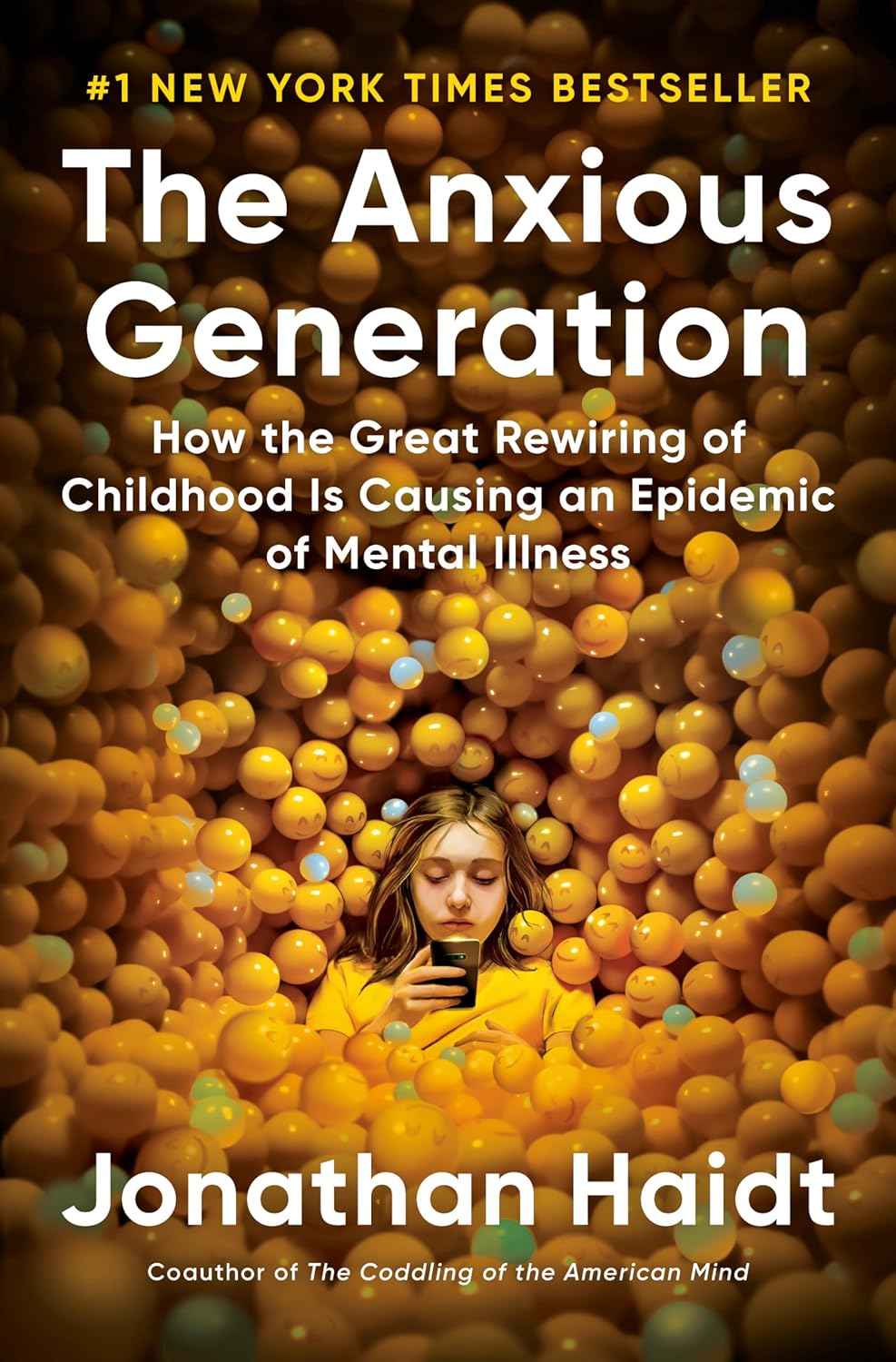Table of Contents
Margaret Hickey
Margaret Hickey is a regular contributor to Position Papers and Mercator. She is a mother of three and lives with her husband in Blarney.
The Anxious Generation: How the Great Rewiring of Childhood Is Causing an Epidemic of Mental Illness
by Jonathan Haidt | Allen Lane, 2024, 295 pages
Jonathan Haidt is Thomas Cooley Professor of Ethical Leadership at New York University’s Stern School of Business. He is the author of several books that explore other aspects of cultural brittleness in contemporary American society. His latest book is a comprehensive exploration of how young minds are damaged by the addictive use of electronic devices.
Haidt also brings the lived experience of a parent who has raised two children in urban America, negotiating a fine line between contemporary culture’s obsession with safetyism and the risks and hazards of digital, and in particular, social media.
Haidt’s leading concerns are the addictive nature of digital technology and its adverse impact on developing and malleable young brains. It’s important that children have the right learning experiences “at the right time, because neurons that fire together wire together”.
In childhood and adolescence, the frontal cortex of the brain develops in response to the social and cultural stimuli experienced. If young minds are to develop in a healthy way, they need real-life interactions as opposed to virtual ones.
In the digital world, “friends” are acquired with a click and can be lost as quickly. In real life, people can’t be so easily disposed of. Relationships with real people are rooted in shared spaces whether in school, neighbourhood or home. Real-life interactions teach children self-governance, negotiation, understanding of and respect for difference and a host of other skills that prepare them for adult life.

Manufactured addiction
The virtual world of digital media sucks children and teens into a highly manipulative and addictive realm that can be almost impossible to escape from. Haidt shows that the addictive quality of digital media is cynically intentional. As the technology develops, more and more “hooks” are added to hold the attention of users.
“Companies,” he writes, “have developed addictive apps that sculpted some very deep pathways in our children’s brains.” You don’t need research to convince you that brain pathways developed at formative stages of life are hard to erase.
Adults with multiple work and life commitments and a childhood experience of growing up without the ubiquitous connectivity of digital devices know how hard it is to ignore the pings that alert us to new notifications of one sort or another. For children whose sense of self can be so bound up with their online activity and that of their friends or role models it is easy to imagine just how difficult it is to disengage from their devices once habits are set.
Haidt finds that it is Generation Z, born after 1995, who are most damaged because they grew up in a world of “hyper-viralised social media”. As they entered their teens, Facebook added the “Like” button and Twitter the “retweet” option. Instagram, with its focus on the visual, arrived around the same time.
We all have a need for validation and affirmation, but it can be emotionally critical for the young and insecure. “Likes” can become the measure of self-worth, but keeping up is not easy with the squalls of new posts and updated profiles. Yesterday’s “likes” mean nothing if one’s latest offering is ignored or thumbed down, especially by someone with social prestige.
Innate differences
Haidt notes that “while boys and girls have similar psychology in most ways”, a statement that will raise eyebrows in many readers, girls and boys are affected differently by social media. Boys are more drawn to online gaming and porn, both of which are highly addictive. The effect on the male psyche shows in anti-social, sometimes even criminal behaviour.
He also observes that changes in work practice, added to obsessive screen time for recreation, leave male energy without its traditional outlets. As a result, males tend to “externalise” the negative impact of digital addiction. Females, on the other hand, who focus more on socially interactive platforms, are more likely to “internalise”. Depression, self-harming and eating disorders are more associated with girls.
Addiction is fuelled by dopamine, but “dopamine, though pleasurable, doesn’t trigger satisfaction but rather a craving for more”. The digital giants understand well how to entice users of all ages, genders and dispositions and keep them engaged to maximise commercial revenue. Digital media feeds on our desires, needs, insecurities and natural curiosity about the lives of others. As with all addictions, overcoming dependency requires making a decisive break with entrenched habits and filling the space with healthier and more life-enriching alternative pursuits.
Haidt offers very specific advice to parents on how to fix the problem. It’s not just the children, but also the adults who need to change their digital patterns of activity. Good examples must be set by parents. Boundaries must be defined and perhaps first negotiated. Unlike forms of substance addiction, moderation and regulation rather than elimination is the best approach to digital addiction.
It might strike some readers that Haidt’s approach is overly liberal and accommodating. For instance, he advises that one hour of screen time on weekdays is appropriate for two to five-year-olds, with three hours on weekend days. That, however, might be realistic given the exigencies of contemporary living for parents for whom parenting is a responsibility that has to constantly weave through a myriad of other commitments relating to work and home and the complicated logistics of modern life.
Encourage independence
Haidt emphasises the need to encourage children to explore the world in free, unsupervised play and to overcome our fixation with safetyism. There is such potential even in play spaces that offer children little more than junk to trigger their imaginations and desire to explore and promote their natural inventiveness and creativity. “Safetyism,” he writes, “is dire for boys.”
He advises parents to lower their risk aversion. Children go into adulthood unprepared if they are overly protected in the formative years. This, of course, is age-old wisdom, but the world is markedly more dangerous now because of many factors, and many parents would be loath to allow a seven-year-old to walk alone to school even on a well-travelled route, as Haidt recommends. Haidt recognises this reluctance and urges that parents come together in solidarity to adopt common approaches and strategies to change the culture of excessive safetyism.
He is right, of course. Unless attitudes change, any parent who trusts a child to play alone in a park, where other children and adults are present, is likely to have their child returned to them by a police officer. That said, it is hard to see how our sense of risk to children can be dialled back when we hear about intercepted abductions on newsfeeds and have collectively formed the view that the only reason such things happen rarely is because of the heightened vigilance of parents and others responsible for the care of children. Indeed, such a preoccupation with safety carries a downside, but for many, perhaps most, parents today, there is too much at stake to lower the parental guardrails in the way previous generations felt able to do.
Holistic development
Haidt, of course, is right in emphasising how healthy maturation requires giving children a rounded experience of life in all its aspects. The disembodied interactions of social media, what writer Mary Harrington calls “thin, dematerialised relationships”, are stunting and alienating. Connecting with real people in the pursuit of real-life activities like sports and other pursuits teaches all kinds of life skills and nurtures deep, enriching friendships. Haidt also grasps that the needs of heart and spirit can’t be fully satisfied without some connection to the “sacred” as well.
Haidt writes, “If we don’t fill it (the heart) with something noble and elevating, modern society will quickly pump it full of garbage”. That, of course, will happen with or without the internet. Arguably, the digital world is neutral in this regard, since it gives access to high culture as well as low and offers a tremendous array of worthwhile resources and platforms relating to spirituality and faith.
Haidt is an atheist, and his idea of “self-transcendence” is secular. It involves exploring the beauty of the natural world and adopting practices with religious origins like “digital Sabbaths” and mindfulness. Self-transcendence takes us beyond the boundaries of our usual routines and self-absorption, but it’s a limited understanding of transcendence.
Haidt believes “the God-shaped hole in every human heart”, quoting Pascal, can be filled “with or without God”. Indeed, it is true that one of the ways God draws us to Himself is through His creation in both its human and natural manifestations. Self-transcendence can be the gateway that leads to the Creator. In the final analysis, as St Augustine found out, it is only God Himself who can fill the God-shaped hole of Pascal.
A wider view
After reading The Anxious Generation, one wonders if the toxic aspects of social media and digital media in general explain the gnawing malaise of our time. Addiction takes more than one form in modern life. It is doubtful that it is mere availability and opportunity that can be blamed entirely for any addiction. Broader environmental factors at play are hugely significant, too. Not everyone grows up damaged.
For many decades before individually owned devices like laptops and smartphones, the screen played a dominant role in the lives of children and teens. TV and the old game consoles could be addictive, too. The earlier screens also immersed people in virtual worlds and vicarious experiences. They, too, were socially distancing and presented fantasy, glamour and excitement that could make real life seem uneventful and dull for young people.
For Haidt, the key difference, of course, is the interactive nature of digital media, its power to build up personal profiles and destroy them. The correlation between the advent of social media apps and the marked deterioration in mental health among the young seems conclusive enough. However, as in debates about all other addictions, it is surely worth considering the wider social context in which this plays out.
Over the last number of decades, family life has collapsed in the West. Novel, reality-denying notions of what constitutes family, that set adult choices over children’s needs, must surely contribute in no small measure to the social withdrawal and alienation of the young.
Also, the impact of social media on parents’ own lives and the way it can engross their attention inevitably impacts the quality of the time they give their children. The other stresses, complications and logistical complexity of modern life add their own share of angst to the mix.
So, while Haidt makes a very convincing case and issues a necessary and serious wake-up call to parents and media regulators alike, there is [likely] more than one factor to be considered in the rising anxiety of our young adults, teens and children.
How can we combat the negative effects of digital technology on our youth? Leave a comment below.









